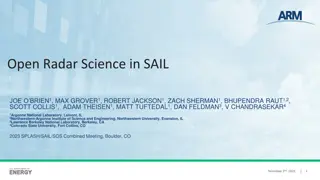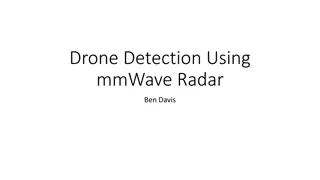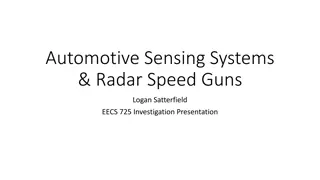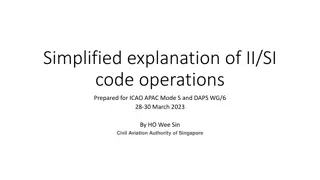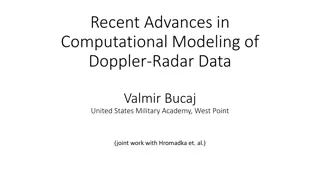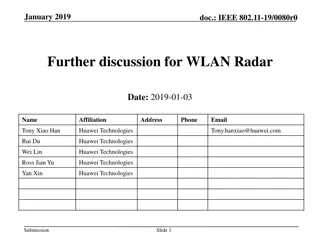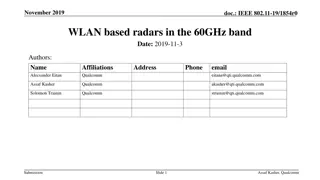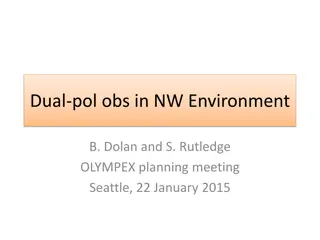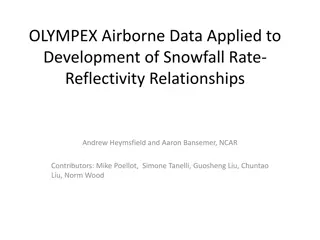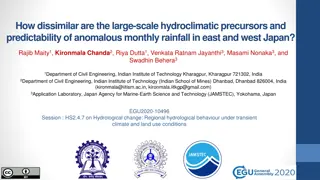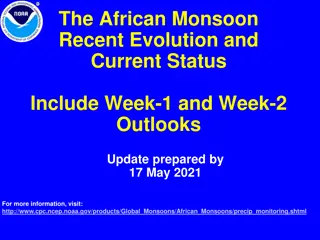Passive Microwave Rainfall Error Analysis Using X-Band Radar Observations in Complex Terrain
Characterizing passive microwave retrieval uncertainty with XPOL observations in complex terrain. Evaluation of satellite precipitation products over complex terrains. Comparison of different algorithms for rainfall error analysis using high-resolution radar observations in North Carolina and North Italy from 2014. Insights into the performance and improvement of GPROF algorithms. Retrieval of extreme precipitation events using satellite-based products for hydroclimatic hazards.
Download Presentation

Please find below an Image/Link to download the presentation.
The content on the website is provided AS IS for your information and personal use only. It may not be sold, licensed, or shared on other websites without obtaining consent from the author.If you encounter any issues during the download, it is possible that the publisher has removed the file from their server.
You are allowed to download the files provided on this website for personal or commercial use, subject to the condition that they are used lawfully. All files are the property of their respective owners.
The content on the website is provided AS IS for your information and personal use only. It may not be sold, licensed, or shared on other websites without obtaining consent from the author.
E N D
Presentation Transcript
Using XPOL Observations from Complex Terrain Field Experiments to Characterize Passive Microwave Retrieval Uncertainty Yagmur Derin1, Emmanouil Anagnostou1, Marios Anagnostou2,3,4, John Kalogiros3 1University of Connecticut, Department of Civil and Environmental Engineering, Storrs-Mansfield, CT, USA (manos@uconn.edu) 2Dept. of Water Resources and Env. Engineering, School of Civil Engineering, National Technical University of Athens, Athens, Greece 3National Observatory of Athens, Institute of Environmental Research & Sustainable Development, Athens, Greece 4DUTH, School of Engineering, Department of Environmental Engineering, Xanthi, Greece August 22nd 2018 PMM Land Surface Working Group
Multi-regional Satellite Precipitation Products Evaluation over Complex Terrain Rain Gauge corrected SBR Satellite only SBR Derin, Y., E. N. Anagnostou, A. Berne, M. Borga, B. Boudevillain, W. Buytaert, C-H. Chang, G. Delrieu, Y. Hong, Y. C. Hsu, W. Lavado-Casimiro, B. Manz, S. Moges, E. I. Nikolopoulos, D. Sahlu, F. Salerno, J-P. Rodrigues-Sanchez, H. J. Vergera, and K. K. Yilmaz, 2016: Multi-regional satellite precipitation products evaluation over complex terrain. J. Hydrometeor., 17, 1817-1836.
Multi-regional Satellite Precipitation Products Evaluation over Complex Terrain Legend Rain Gauges Lower gauges SBR values elevation corresponding rain Higher gauges SBR values elevation corresponding rain Derin, Y., E. N. Anagnostou, A. Berne, M. Borga, B. Boudevillain, W. Buytaert, C-H. Chang, G. Delrieu, Y. Hong, Y. C. Hsu, W. Lavado-Casimiro, B. Manz, S. Moges, E. I. Nikolopoulos, D. Sahlu, F. Salerno, J-P. Rodrigues-Sanchez, H. J. Vergera, and K. K. Yilmaz: Multi-regional Evaluation of Satellite Precipitation Product IMERG over Complex Terrains. Under Preparation.
Multi-regional Satellite Precipitation Products Evaluation over Complex Terrain Y. Derin, E. Nikolopoulos and Anagnostou., M. N., 2018: Retrieving Extreme Precipitation with Multiple Satellite-based Precipitation Products, Extreme Hydroclimatic Events and Multivariate Hazards in a Changing Climate, Elsevier
Passive Microwave Rainfall Error Analysis Using High-Resolution X-Band Dual-Polarization Radar Observations in Complex Terrain North Carolina May 1- June 15 2014 21 Days 34 Days North Italy August 1 Oct 15 2014 Main Results; The magnitude-dependent systematic error, going from overestimation or weak underestimation of light precipitation to mainly underestimation of heavier precipitation, shows weak covariation with the ground reference. GPROF V5 algorithm depicted significant improvement over its previous versions (V3 and V4). In general, the GPROF-CLIM algorithm and GPROF V5 showed the best performance in terms of correlation and systematic error for both regions Derin, Y., Anagnostou E., Anagnostou M. N., Kalogiros J., Casella D., Marra A. C., Panegrossi G., and Sano P., 2018: Passive Microwave Rainfall Error Analysis Using High-Resolution X-Band Dual-Polarization Radar Observations in Complex Terrain. IEEE Transactions on Geoscience and Remote Sensing, 56:5, 2565-2586; 10.1109/TGRS.2017.2763622
Passive Microwave Rainfall Error Analysis Using High-Resolution X-Band Dual-Polarization Radar Observations in Complex Terrain Derin, Y., Anagnostou E., Anagnostou M. N., Kalogiros J., Casella D., Marra A. C., Panegrossi G., and Sano P., 2018: Passive Microwave Rainfall Error Analysis Using High-Resolution X-Band Dual-Polarization Radar Observations in Complex Terrain. IEEE Transactions on Geoscience and Remote Sensing, 56:5, 2565-2586; 10.1109/TGRS.2017.2763622
Analysis of X-Band Dual Polarization Radar Observations in OLYMPEX Quantify precipitation and microphysical parameters from the OLYMPEX Doppler on Wheels (DOW) dual-polarization X-band radar. Evaluate accuracy of these estimates against in-situ measurements disdrometers, rain gauges and MRR. Use the OLYMPEX demonstrate the value of locally deployed radar as a gap fill to operational radar networks in complex terrain (i.e. NEXRAD). from experiment to DOW In-situ stations
Datasets DOW sector volumes contain scans at 6 elevations app ~ 2.8, 3.0, 5.0, 7.0, 9.0 and 11.0 degrees DOW properties Range Gate Length Pulse Length Beam Width Beam Indexing 0.25 deg 59.96 km 75 m 500 ns 0.93 deg Lowest elevation angles Highest elevation angles Range from DOW (km) Site IDs Instruments Elev (m) DOW - 72 DOW APU07, NASA0036 APU08, NASA0029 APU09, STDALN01 APU11, STDALN02 Parsivel, Gauges 4.65 65 Close in-situ stations Parsivel, Gauges, MRR 5.34 87 Parsivel, Gauges 15 116 Far stations in-situ Parsivel, Gauges 23 181
SCOPE-ME ALGORITHM Precipitation Algorithm Quality control ( HV, Vr, Vr, signal above noise level): real-time ground clutter detection and suppression beam blockage correction rain signal areas detection ( HV>0.8) differential phase filtering (phase continuity, 1- 3 km linear filter for KDP) Attenuation correction: KDP-based iterative differential phase algorithm along each ray Bright-band detection and correction for VPR: HV based PPI areal method or RHI profile method Rain rate and microphysical parameters estimation (SCOPE-ME) Anagnostou, M. N., John Kalogiros, Frank S. Marzano, Emmanouil N. Anagnostou, Mario Montopoli, and Errico Picciotti, 2013: Performance evaluation of a new dual-polarization microphysical algorithm based on long-term X-band radar and disdrometer observations, J. Hydrometeor.14, 560 576. Kalogiros, J., M. N. Anagnostou, E. N. Anagnostou, M. Montopoli, E. Picciotti, and F. S. Marzano, 2014: Evaluation of a new Polarimetric Algorithm for Rain-Path Attenuation Correction of X- Band Radar Observations Against Disdrometer Data, IEEE Geoscience and Remote Sensing Letters,52, 1369 1380.
Reflectivity Comparison at Lowest Elevation Angle Measured Zh Closest Disdrometers Corrected Zh ??? = (????? ?? ?????? ??) ?????? ?? Height of the beam = 304, 340 m Height of the beam = 875, 2380 m Farthest Disdrometers
Reflectivity Comparison at Highest Elevation Angle Corrected Zh Measured Zh ??? = (????? ?? ????????? ??) ????????? ?? Closest Disdrometers Height of the beam = 930, 1060 m Farthest Disdrometers Height of the beam = 3025, 8330 m
Reflectivity Comparison at Lowest & Highest Elevation Angle Lowest Elevation Angle Highest Elevation Angle Radar Zhm Radar Zh ???? = ????? ?? ?????? ??
Rainfall Comparison for Lowest Elevation Angle Hourly Rainfall Closest in-situ stations ??? = (??? ? ????????? ?) ????????? ? 15 min Rainfall
Rainfall Comparison for Highest Elevation Angle ??? = (??? ? ????????? ?) ????????? ? 15 min Rainfall Hourly Rainfall Closest in-situ stations
Rainfall Comparison for Lowest & Highest Elevation Angle Lowest Elevation Angle Closest RGs Highest Elevation Angle Farthest RGs Hourly Rainfall Hourly Rainfall 15 min Rainfall 15 min Rainfall
Event-based Accumulated Rainfall Event: 2015 12 09 Event: 2015 12 08 Event: 2015 12 13 Disdrometer Rain Gauges
Event-based PDFc (PDF by occurrence of rain rates) and PDFv (PDF by volume of rain rates) Event: 2015 12 08 Event: 2015 12 09 Event: 2015 12 13
Closing Remarks Our error analysis over North Carolina and Northeast Italy showed that PMW-based estimates have systematic underestimation particularly of high rain rates. In addition we showed that GPROF algorithm (both versions) applied on GMI has the least conditional bias. Almost all sensors have problem detecting light precipitation rates, however, performance varies across different algorithms. The XPOL algorithm presented in this study would facilitate more comprehensive investigation of those PMW retrieval error characteristics, because the XPOL estimates were shown to have consistently low bias and random errors across different radar ranges and rainfall magnitudes. In addition, we showed that rainfall estimation error statistics is comparable to random error evaluated by comparing collocated in- situ stations.
Future Work Apply XPOL estimates to study PMW retrieval uncertainty Extend the work to additional complex terrain study areas capitalizing on their local XPOL observations. Ground Radar Location Period Collaborator 07/2014-09/2014 (21 events) X-POL Northeast Italian Alps John Kalogiros, NOA 05/2014-06/2014 (25 events) NOXP Appalachian, North Carolina NASA, IPHEX Processed 10/2015-02/2016 (39 events) DOW Olympic Mountain, Washington NASA, OLYMPEX 09/04/2014-10/13/2014 (35 events) 07/31/2015-09/30/2015 (53 events) 03/01/2017-04/21/2017 (32 events) Pierre Kirstetter, OU NOXP Rocky Mountains, Colorado 02/2014 03/2014-06/2014 06/2014-05/2015 11/2016-current Swiss Alps Alexis Berne, EPFL X-POL To be processed 01/18/2018-04/02/2018 (45 events) NOXP Andes, Peru Boonleng Cheong, OU 09/2012-10/2012 09/2013-current French Cevennes & Alps Guy Delrieu Univ. of Grenoble X-POL Alexis Berne, EPFL ICE-POP X-POL Korea 01/14/2018-03/12/2018 X-POL Arizona 2018 summer (to be deployed) 2018 (to be deployed) Jonathan Gourley, OU Joseph C. Hardin, Pacific Northwest National Laboratory Sierras de C rdoba Mountain range, Argentina X-POL




